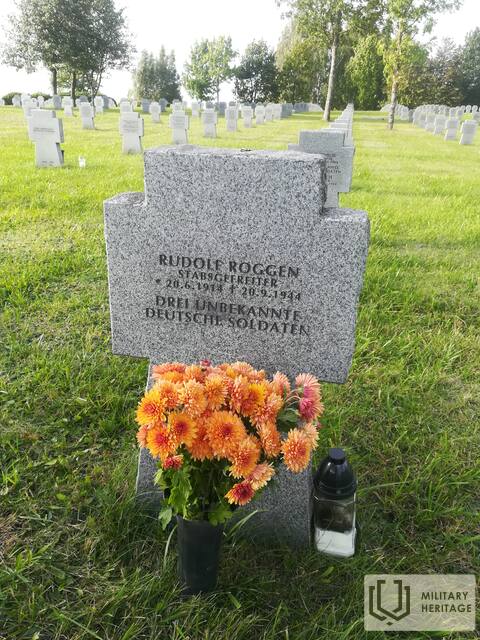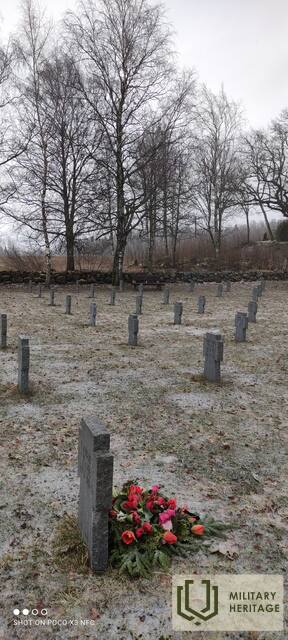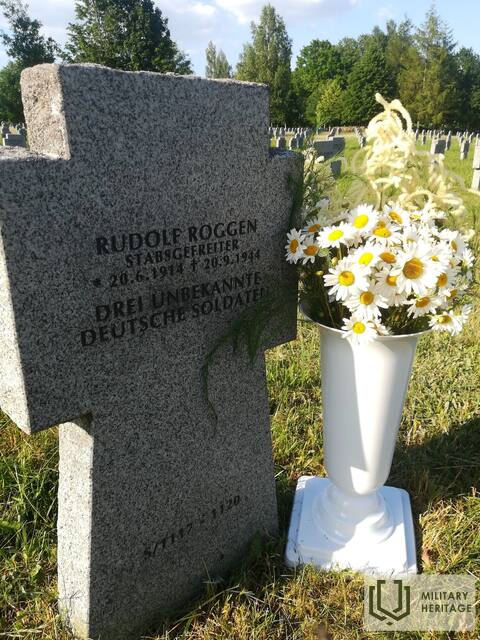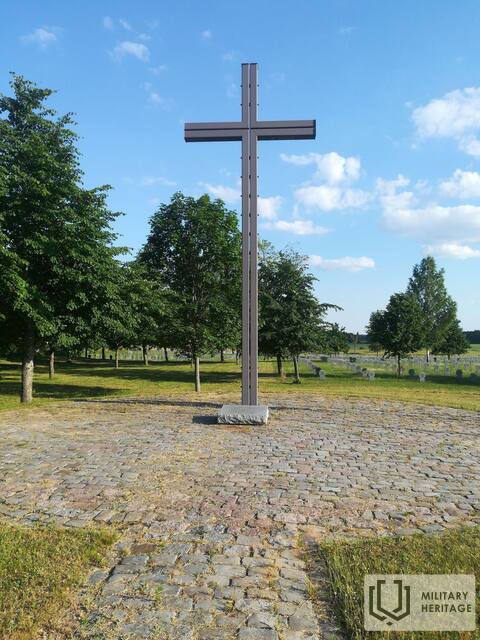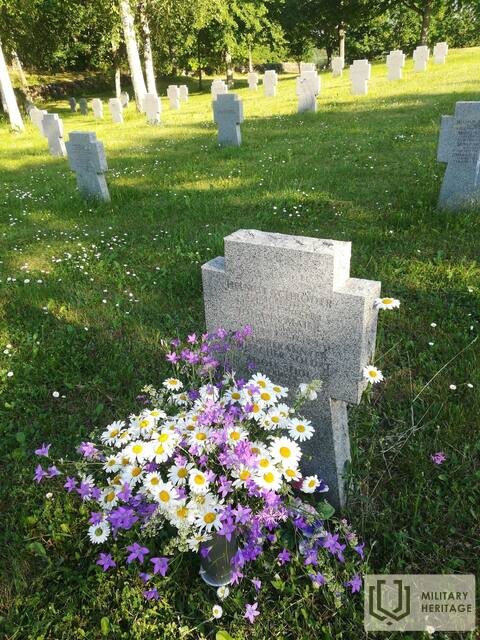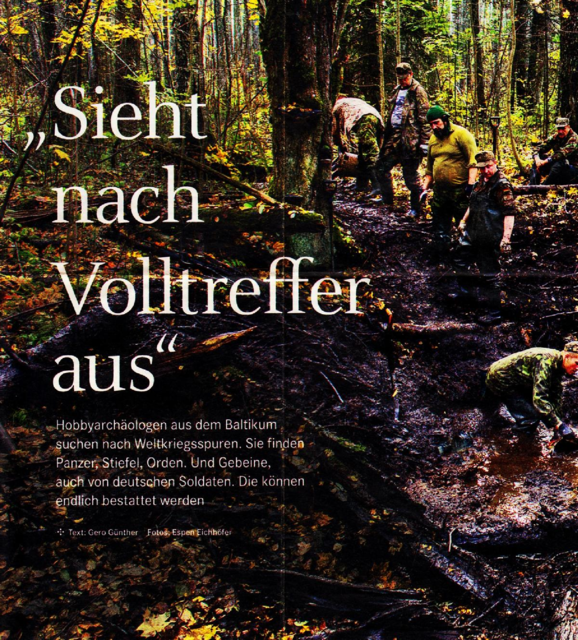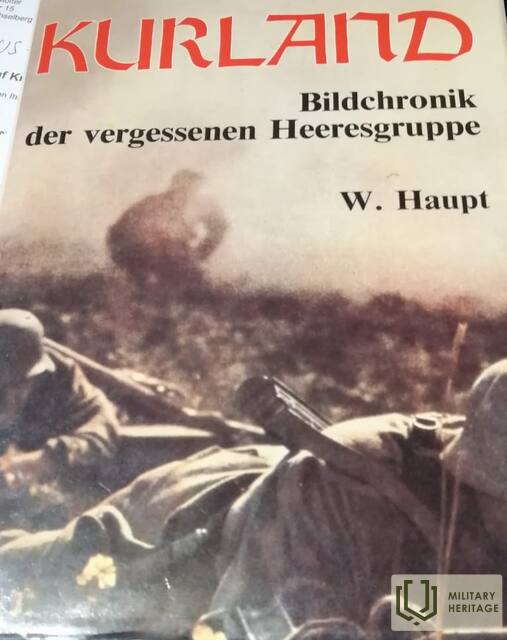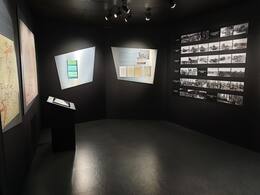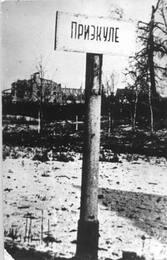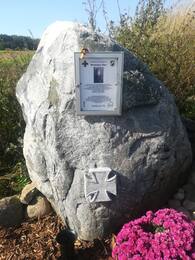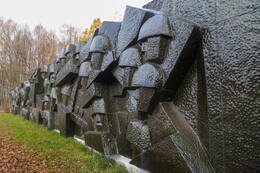"The war is not over until the last soldier is buried" (Saldus German Soldiers' Cemetery)
Kurzeme kā atsevišķs un nošķirts kaujas lauks izveidojās 1944. gada 10. oktobrī. Apmēram 500 000 Vācijas bruņoto spēku karavīru skaitījās ielenkti. Atbilstoši 1. Baltijas frontes štāba ziņojumiem, bija nepieciešama tikai "neliela piepūle", lai pilnībā atbrīvotu visu Baltijas piekrasti. Tomēr kaujas Kurzemē turpinājās vēl septiņus mēnešus un Kurzeme kļuva par Otrā pasaules kara beigu simbolu.
Septiņu mēnešu kauju laikā līdz 1945. gada maijam Vācijas bruņotie spēki Kurzemē zaudēja 154 108 kritušus, ievainotus un bez vēsts pazudušus karavīrus. Kopš 1997. gada sākta kara apbedījumu izpēte un karavīru pārapbedīšana pie Saldus un pašreiz šeit ir atrodami 27 000 kritušo karavīru vārdi
Kurzeme kā atsevišķs un nošķirts kaujas lauks izveidojās 1944. gada 10. oktobrī. Sarkanās armija jau kopš 1944. gada jūlija beigām mēģināja izmantot panākumus Baltkrievijā, kur nepilna mēneša laikā tika iznīcināta vācu armiju grupa “Centrs”. 1944. gada augusta sākumā padomju karaspēka 3. gvardes mehanizētā korpusa vienības ieņēma Tukumu un sasniedza Klapkalnciemu pie Rīgas jūras līča, pārtraucot sauszemes satiksmi starp Vērmahta armiju grupu “Ziemeļi” un Vāciju. Tomēr pirmais Sarkanās armijas mēģinājums satiksmi pārtraukt nebija sekmīgs, jo vācu pretuzbrukuma rezultātā jau 1944. gada augusta beigās sauszemes koridoru pie Tukuma atjaunoja.
Nākamais vācu armijas ielenkšanas mēģinājums sākās 1944. gada 14. septembrī, kad trīs Baltijas frontes ar 1 546 000 karavīru sāka uzbrukumu Rīgas virzienā. Arī šis mēģinājums beidzās nesekmīgi un Sarkanajai armijai nācās mainīt plānus. Trešais mēģinājums, pazīstams ar nosaukumu “Klaipēdas uzbrukuma operācija”, bija ne tikai sekmīgs, bet kļuva par vienu no lielākajiem Sarkanās armijas sasniegumiem Otrā pasaules kara laikā. 5. gvardes tanku armija, sākot uzbrukumu 5. oktobrī, Baltijas jūras piekrasti pie Palangas sasniedza jau 10. oktobra vakarā.
Apmēram 500 000 Vācijas bruņoto spēku karavīru skaitījās ielenkti. Atbilstoši 1. Baltijas frontes štāba ziņojumiem, bija nepieciešama tikai neliela piepūle, lai pilnībā atbrīvotu visu Baltijas piekrasti. Tomēr kaujas Kurzemē turpinājās vēl septiņus mēnešus un Kurzeme kļuva par Otrā pasaules kara beigu simbolu.
Septiņu mēnešu kauju laikā līdz 1945. gada maijam Vācijas bruņotie spēki Kurzemē zaudēja 154 108 kritušus, ievainotus un bez vēsts pazudušus karavīrus. Precīzs kritušo un bez vēsts pazudušo skaits nav zināms, bet varēja sasniegt līdz 50 000 karavīru. Pēc kara beigām vācu karavīru kapsētas padomju vara iznīcināja. Kritušo karavīru ekshumācija no kaujas laukiem un nopostītajām kapsētām sākās 1990. gadu sākumā.
Kopš 1997. gada sākta kara apbedījumu izpēte un karavīru pārapbedīšana pie Saldus un pašreiz šeit ir atrodami 27 000 kritušo karavīru vārdi. Darbi vēl arvien turpinās, jo visas karavīru apbedījumu vietas vēl nav izpētītas. Pārapbedīto karavīru uzvārdi liecina par to, ka vācu armijā starp vāciešiem, austriešiem ir bijuši iesaukti arī latvieši, igauņi, lietuvieši, norvēģi, dāņi un citu tautību pārstāvji.
Saistītās laikalīnijas
Saistītie objekti
Saldus German Soldiers' Cemetery
Saldus German soldier's cemetery is located on the Saldus-Ezere highway. Around 25,000 German soldiers, as well as some Latvian legionnaires, were reburied in the 8-hectare cemetery. Reburial has been taking place since 1997.
From May 1 to October 1, an exposition on the Battle of Kurzeme can be seen in the memorial room. During this period, the memorial room is open on weekdays from 9:00 a.m. to 5:00 p.m., on Saturdays and Sundays the cemetery also has a tour guide. The registers of soldiers buried in Saldus German soldiers' graves and fallen soldiers throughout Latvia are also available.
Ezere local history repository “Muitas Nams” (Customs House)
The Ezere Customs House is located in Ezere near the Saldus-Mažeikiai highway at the Latvian-Lithuanian border. The act of surrender of the German Army units ‘Kurzeme’ (Kurland) surrounded in the so-called ‘Courland Pocket’ was signed in this building on 8 May 1945. It is believed that World War II actually ended in Ezere. The customs house has an exhibit covering the events of the end of World War II and exhibits detailing the history of Ezere parish from ancient to modern days. In the morning of 7 May 1945, the commander of the Leningrad Front, Marshal L. Govorov, sent an ultimatum to the command of the army group ‘Kurzeme’ to lay down arms. The act of surrender was signed by the involved parties on May 8 and it detailed the procedure of surrender, weapons collection points, documents and information to be submitted and other practical measures.
Guided excursion in Priekule “Along the Footsteps of World War II in the "Courland Pocket””
The guided tours feature the battlefields of World War II in the vicinity of the town of Priekule. The duration of the tour can be adjusted to suit the interests of the group: from 10 kilometres in three hours to 40 kilometres in six hours. All year round, the tours are available in Latvian, Russian and English. Tours must be booked in advance. The tours are suitable for travellers from 13 years of age. The most suitable mode of transportation is a car or bus with up to 30 seats. Key stops: Gramzda parish where the Soviet Army initiated its attack on the German Army in Priekule in the autumn of 1944. Priekule Brothers’ Cemetery: the largest Brothers’ Cemetery in the Baltics with more than 23,000 Red Army soldiers resting here. Priekule: a site of strategic importance in the south of the ‘Courland Pocket’ where a particularly heavy and difficult battle was fought. Krote parish where in the February of 1945 the attack of the Soviet Army on the German forces besieged in the ‘Courland Pocket’ stopped on the banks of the Vārtāja river.
Memorial site for Hermann Faul
It is located at the crossroads of rural roads, turning off the road leading from Pienava to Džūkste.
Memorial to H. Faul, and to the nine German and Latvian soldiers who fell in the battle of 27 December 1944 (probably blown up by a direct hit from a cannon shell) and who are presumed missing since then, as no remains, documents or other evidence of their identity have been found.
Priekule Memorial Ensemble of Warrior’s Cemetery
The Priekule Memorial Ensemble of Warrior’s Cemetery is on the Liepāja-Priekule-Skoda road and is the largest burial site of Soviet soldiers of World War II in the Baltics. More than 23,000 Soviet soldiers are buried here. Operation Priekule was one of the fiercest battles in Kurzeme Fortress that took place from October 1944 to 21 February 1945. The Battle of Priekule in February 1945 lasted seven days and nights without interruption and had a lot of casualties on both sides. Until Priekule Warrior’s Cemetery was transformed into a memorial, the last monument of the outstanding Latvian sculptor K. Zāle (1888-1942) was located here to commemorate the independence battles in Aloja. Between 1974 and 1984, the 8 ha Priekule Warrior’s Cemetery was transformed into a memorial ensemble dedicated to those who fell in World War II. It was designed by the sculptor P. Zaļkalne, architects A. Zoldners and E. Salguss, and the dendrologist A. Lasis.
The centre of the memorial holds a 12 m tall statue called the ‘Motherland’, and names of the fallen are engraved on granite slabs. Until Latvia regained its independence, the Victory Day was widely celebrated every year on May 9.
Guided excursion in Priekule “Along the Footsteps of World War II in the "Courland Pocket””
The guided tours feature the battlefields of World War II in the vicinity of the town of Priekule. The duration of the tour can be adjusted to suit the interests of the group: from 10 kilometres in three hours to 40 kilometres in six hours. All year round, the tours are available in Latvian, Russian and English. Tours must be booked in advance. The tours are suitable for travellers from 13 years of age. The most suitable mode of transportation is a car or bus with up to 30 seats. Key stops: Gramzda parish where the Soviet Army initiated its attack on the German Army in Priekule in the autumn of 1944. Priekule Brothers’ Cemetery: the largest Brothers’ Cemetery in the Baltics with more than 23,000 Red Army soldiers resting here. Priekule: a site of strategic importance in the south of the ‘Courland Pocket’ where a particularly heavy and difficult battle was fought. Krote parish where in the February of 1945 the attack of the Soviet Army on the German forces besieged in the ‘Courland Pocket’ stopped on the banks of the Vārtāja river.




